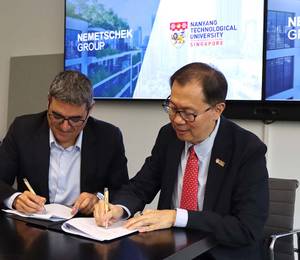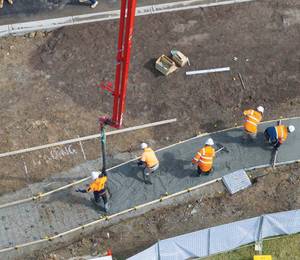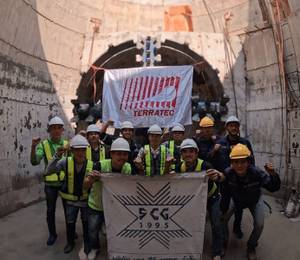The recent arrival of Southeast Asia’s first fully electric construction equipment from Volvo Construction Equipment (Volvo CE), and the trials of the machines at Kim Hock’s facility in Singapore, will likely serve as a springboard for construction companies in the region to begin – or expand – their electrification solutions.
The move is also likely to have wider implications for the region’s construction industry – creating greater awareness of the technology, paving the way for other electric heavy equipment and advanced green innovations, and eventually helping the industry accelerate its sustainability transformation.
Southeast Asia Construction (SEAC) visited the Kim Hock facility to learn more about these electric machines, and talked to Volvo CE about its decision to bring the technology to the region.
‘Increasing focus’ on the region
For the Southeast Asian market, three models are being offered – the ECR25 Electric compact excavator, L25 Electric compact wheel loader and EC55 Electric excavator – aimed at the region’s construction industry. Volvo CE said the machines are available for both purchase and rent. All of them are battery-powered.
The three electric machines launched in Singapore “will act as a launchpad for further sales, both in Singapore and the wider regional market,” said Tomas Kuta, president of Asia region at Volvo CE.
“Singapore is a natural market for electric construction machines with a strong focus on sustainability, efficiency and safety in its construction industry,” explained Mr Kuta. As the Singapore Green Plan 2030 is driving the country forward, he believes that there is strong potential for much wider use of electric machines in the industry.
Speaking with SEAC at the launch event, Mr Kuta acknowledged that the higher purchasing cost of electric machines remains one of the main barriers, especially in Southeast Asia. “We need to provide more education to the industry about the long-term benefits of electric machines, which are substantial, including zero emissions, low noise, fewer vibrations and less maintenance.”
Less maintenance means lower servicing cost, unlike diesel machines that require regular maintenance. “Therefore, owners of electric machines are able to recover their higher purchasing cost through their lower operating cost,” said Mr Kuta. This, combined with the environmental benefits, can make electric machines an appealing choice for the industry.
“Creating awareness of the technology is one area we’re working on,” added AM Muralidharan, head of productivity & retail development for Asia at Volvo CE. “This is the reason we’re offering trials for our customers, so that they have the confidence to use the machine.” He mentioned that in Singapore, the awareness of such technology is “getting better, and we’re already seeing that there are customers who want to use the machine. We cannot underestimate this transformation.”
Although the battery-electric technology is still in its early stage of development, it is evolving at a rapid pace around the world. This is a good sign for the industry, because “as the demand increases and the technology advances, the price of batteries will drop and in turn reduce the cost of electric machines,” said Mr Kuta.
Another challenge in the region that Mr Kuta pointed out is the scarcity of charging infrastructure for electric construction machines. “This is a government-driven effort and it varies from country to country.”
To support customers’ needs, Volvo CE offers charger options for its electric machines. “We have slow and fast chargers,” shared Mr Muralidharan. “With the slow charger, the charging time is about seven to eight hours, or the whole night. If you want to charge during lunch time, we recommend to use the fast charger, which takes up to two hours.”
Mr Kuta further highlighted that the lack of government support for electric construction equipment also discourages the industry from taking the first step. “The government needs to lead the way in order to accelerate the electrification process,” opined Mr Kuta. “The countries with a high adoption rate of electric construction machines have shown that the government can really help speed up the process, for example, by offering subsidies to manage the initial cost.”
The introduction of Volvo CE electric machines in Singapore is the company’s fifth launch in Asia, following China, South Korea, India and Japan. “We’re increasing our focus on the Southeast Asia region, as it has become an important market for us,” said Mr Kuta. “We’ve seen some countries progressing in a positive and stable manner, like Indonesia and Malaysia.”
Mr Kuta also sets his sights on the Philippines, Thailand and Vietnam. Altogether, “there are a lot of opportunities in the emerging markets across Southeast Asia, which will continue to grow over the coming years.”
The journey towards 2040
In the past couple of years, Volvo CE has steadily rolled out its electric construction machines to countries around the world, focusing on those with the strongest potential. “Our company wants to reach net-zero emissions by 2040, and as part of that and our commitment to Science Based Targets, we want to reduce emissions from our product line by 30% by 2030, as well as reducing emissions from our own operations by 50% in the same timeframe,” explained Mr Kuta.
Volvo CE aims to have 35% of the machines it sells powered by electromobility by 2030. According to the company, it already provides the widest range of electric construction machinery for the industry today.
Mr Kuta revealed that Volvo CE is no longer making any investments in the development of diesel-driven compact equipment up to 5 t. The company’s existing models are only available for production. “By 2040, we want 100% of the vehicles we produce to be fossil free. We expect a gradual shift into battery electric and fuel-cell electric vehicles.”
“Our compact machines up to 20 t are battery powered, while the larger-capacity models come with cable electric,” said Mr Muralidharan. “We are doing more than just converting diesel to electric; we are also looking into motion recuperation – how we can save the energy and use it in a more efficient way through some sort of movement, like the braking system.”
Other innovations that Volvo CE is currently developing include alternative fuel and hydrogen fuel-cell machines. In achieving net-zero emissions by 2040, the company has announced that it will work together with its supply partners and focus on circularity, in addition to setting its interim goals by 2030.
Mr Kuta noted, however, that “the decarbonisation journey will take place at different rates in different parts of the world. We have separate timelines for each of the regions, but all of them are on the same path to meeting our 2040 target.”
Among Volvo CE’s recent sustainability initiatives in Southeast Asia is the opening of a component rebuild centre in Indonesia, through its dealer PT Indotruck Utama (ITU). Mr Kuta said Volvo CE is keen on exploring a similar approach in the region. “Having a local rebuild facility is much more environment-friendly. Plus, it shortens parts delivery time as we’re closer to our customers.”
Furthermore, Volvo Group has recently established a new division called Volvo Energy, which will manage all batteries used within the group – including those of construction equipment – at the end of their lifecycle. “It will look at various solutions, such as recycling batteries or reusing them for other types of applications,” said Mr Kuta.
Without doubt, the push towards the adoption of electric equipment represents an important solution that will help accelerate the sustainability transition in the construction industry – but it is not a one-way process. As Mr Kuta reiterated, “Make no mistakes, this is a major change not only for OEMs, but also for all stakeholders – owners, developers, contractors, distributors, and the governments. It is a combined effort.”
Note: The longer version of this article (with more images) has been published in the Jul/Aug 2023 issue of SEAC. Click here to read online or here to download the PDF file (pages 58-62)
Related News:
Kim Hock to use SE Asia’s first fully-electric Volvo construction machines
SE Asia’s first fully-electric Volvo construction machines arrive in Singapore















